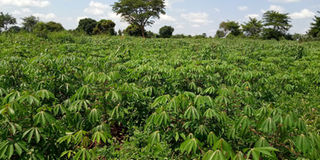Experts give remedies to cassava diseases

Dr Ambrose Agona giving remarks. COURTESY PHOTO
What you need to know:
Farmers must also avoid newly cleared forest land since rotting tree leaves may habour bacteria that cause dry rot disease, writes Lominda Afedraru.
Cassava is a staple food crop for more than 800 million people worldwide, and it is a food security crop with the tubers lasting two and three years in the soil. In Uganda, it is grown by more than 70 per cent households, generating 22 per cent household incomes to the rural poor.
It is capable of growing on marginal soils and can be planted and harvested any time of the year. It tolerates unexpected droughts.
However, despite its importance, production constrained by pests and diseases in the country is prevalent with the major diseases such as Cassava Brown Streak Diseases (CBSD) and Cassava Mosaic Virus (CMD) spread in farmer fields by whitefly.
As such, scientists at the National Crop Resources Research Institute (NaCRRI) at Namulonge are engaged in applying upcoming technologies in a bid to develop varieties which are tolerant to the diseases for farmers to realise better yields.
Tom Omara, a research assistant at the institute, explaining the burden of the insect in cassava fields, notes that whiteflies are found in all cassava growing areas of Uganda. They are tiny white insects found on the underside of the young leaves of cassava, where they feed and lay many eggs.
The eggs develop through instar stages and it takes about one month to become adults. By feeding on cassava leaves, whiteflies cause damage to the plant and spread CMB and CBSD. By sucking sap from the leaves, the insects excrete a sugary substance, causing honey dew drops on the lower leaves.
Agronomy
Gerald Adiga, a research assistant at the Institute, takes Seeds of Gold through the best practices noting that it is a versatile crop for growing cassava. This crop also has the highest amount of starch, which can be best intercropped with legumes and cereals.
Cropping systems
Cassava production in Uganda occurs within a variety of cropping system: which include monocrop where a farmer grows cassava as the only crop on the plot. This is found mainly on large-scale commercial farms. Intercrop alongside other crops on the same plot at the same time and crop rotation where different types of crops are grown in the same area in sequenced season.
Site selection
Ideally, fertile well drained land on a flat terrain or gentle slope should be selected.
Steep slopes should be avoided as they could be erosion-prone. Avoid stony or rock and shaded areas including swamps or places which are likely to flood during the rainy season. Farmers must also avoid newly cleared forest land since rotting tree leaves may habour bacteria that cause dry rot disease. Forest soil contains high level of nitrogen that favours foliar growth instead of root yield.
Land preparation
Land preparation should be done at the
end of a dry season to allow for planting at the first rains of a rainy season.
Land preparation method depends on whether the land has previously been under cultivation or managed fallow.
Farmers must begin by slashing or removing tall grasses and shrubs and ploughing before planting to loosen soil for healthy root establishment.
Ploughing may be done by using a hoe, by ox-plough or a tractor. The depth of ploughing should be 15-30 cm deep to prevent nutrient rich top soil from moving down too deep.
Varieties for planting
There are 21 improved varieties of cassava which are adapted in various agro-ecological zones.
In commercial cassava production, market requirements are a major consideration in deciding the variety to plant.
In both commercial and subsistence production it is recommended that farmers use disease-resistant varieties.
The plants from which the cuttings are taken are free of signs of disease, such as CMD and CBSD.
The implements used to cut stems are clean and have not been used on infested planting material. Select stems from cassava that is 10 - 18 months old.
Ensure that cuttings are: freshly harvested and of at least 2cm diameter and 20-25 cm long, with 5-7 nodes ideally taken from the bottom end of the stem and not with green bark.
Planting depth should be between six and 10 cm in holes of 20-30 cm width and hole spacing should be one meter between plants and one meter between rows.
Harvesting
First harvesting period depends on the variety grown and most improved cassava varieties can be harvested from 12 months.
Harvest by digging the soil around the roots and hand pulling. The yield estimate for local varieties is between six and 15 tonnes per hectare while improved varieties can give you 12 to 60 tonnes per hectare.
Ratooning can be done for farmers intending to sell stems to allow re-growth. Older stems from main fields may be cut 10-11 months after transplanting and seven to eight months after every subsequent cutting.
Value addition
Dr Ephraim Nuwamanya of the Biochemistry Lab at NaCRRI explained that appearance of new products in recent years is on the rise and this includes high quality cassava flour for making alcohol in brewing industries.
Cassava starch for making bio-degradable bags and different drug carriers are made out of starch used to mix with active pharmaceutical materials to make capsules and tablets.
Cassava for making fish feed which involves harvesting and preparation for fermentation with lactobacillus followed by yeasts to enhance nutritive value, wet milling and drying flour and mixing with necessary protein.




